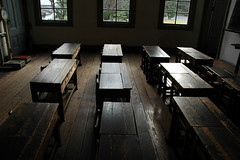| May 2008 | ||||||
| Sun | Mon | Tue | Wed | Thu | Fri | Sat |
| 1 | 2 | 3 | ||||
| 4 | 5 | 6 | 7 | 8 | 9 | 10 |
| 11 | 12 | 13 | 14 | 15 | 16 | 17 |
| 18 | 19 | 20 | 21 | 22 | 23 | 24 |
| 25 | 26 | 27 | 28 | 29 | 30 | 31 |
| Apr Jun | ||||||
 My last full day here in Australia before the long trip home tomorrow. I get my day back, but who knows how long it will be before I get my body clock back. Last summer it took almost two weeks for me to get straight. Tips anyone? (Be nice.)
My last full day here in Australia before the long trip home tomorrow. I get my day back, but who knows how long it will be before I get my body clock back. Last summer it took almost two weeks for me to get straight. Tips anyone? (Be nice.)
Haven’t had time to think much of this through, so excuse the relatively thin thinking. (Feel free to poke holes in it, as always.)
I’ve visited a couple of pretty interesting schools during my visit, one that’s in the process of being built, another that’s been around for 30 years, both different in their design. The new school, a high school, will be one built on open spaces for learning, project based learning concepts, individualized learning plans and very different roles for teachers and classrooms. The spaces have been designed with the great thinkers in mind, DaVinci and Einstein spaces, spaces that on blueprint at least offer up a great deal of potential for creativity and independence and passion based learning. Arts are embedded in the curriculum, and there is a really different concept of assessment. With any luck, I’ll be writing more about this place in the near future.
The other school was out in the country, surrounded by fields filled with cows and chickens and pigs. It was a small, PreK-6 school where the classrooms had all sorts of angles and skylights and patterns. Everywhere you look there is evidence of performance learning. Every classroom has a kitchen where kids do a lot of cooking. Outside, playground spaces are performance spaces as well. And the kids tend to the livestock and the farm as well as the school. I loved the feel.
Technology plays a role in both of these schools, though the roles are different to be sure. The high school will be a 1-1 school. The other is expanding the access of computers to its kids. Both are ripe for the ways in which technology can supplement real learning in the classroom, not just information processing. Obviously, there is much more about the culture and the infrastructure and the climate that goes into all of this.
The early thinking that’s evolved from those visits for me is this: we have been living in a world with pretty much one, ubiquitous model for schools for a long time now. This strikes me every time I take off on a plane to somewhere and am able without any trouble to pick out the school buildings we’re flying over. They’re all at right angles, with baseball and football fields nearby. The sizes and number of buildings vary, but it’s rare that I see yellow school buses parked next to anything that looks like something other than a factory.
In my own thinking about what schools might become, I’m realizing that I’ve been thinking that this old model is going to turn into a different model. But what’s really going to happen, I think, is that we’re about to explode into many different models. Obviously, this may not happen with any great momentum until we free up our ideas about assessment and learning culture, neither of which is an easy road. But we do need to find ways to support more unique, passion-based schools, places that like our kids, come in all shapes and sizes. I can’t remember when he said it, whether blog or e-mail, but Tom Hoffman reminded me a while ago that we have a lot of different models out there already, many of which are successful in their own right. And as we move away from that one factory model, we need to be open to whatever types of new models might evolve.
(Photo “old classroom” by shuichiro.)
[Weblogg-ed]2:16:19 PM